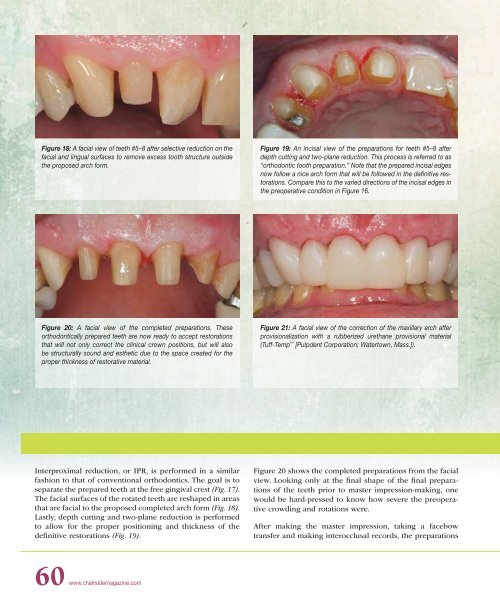PDF Version - Glidewell Dental Labs
PDF Version - Glidewell Dental Labs
PDF Version - Glidewell Dental Labs
Create successful ePaper yourself
Turn your PDF publications into a flip-book with our unique Google optimized e-Paper software.
Figure 18: A facial view of teeth #5–8 after selective reduction on the<br />
facial and lingual surfaces to remove excess tooth structure outside<br />
the proposed arch form.<br />
Figure 19: An incisal view of the preparations for teeth #5–8 after<br />
depth cutting and two-plane reduction. This process is referred to as<br />
“orthodontic tooth preparation.” Note that the prepared incisal edges<br />
now follow a nice arch form that will be followed in the definitive restorations.<br />
Compare this to the varied directions of the incisal edges in<br />
the preoperative condition in Figure 16.<br />
Figure 20: A facial view of the completed preparations. These<br />
orthodontically prepared teeth are now ready to accept restorations<br />
that will not only correct the clinical crown positions, but will also<br />
be structurally sound and esthetic due to the space created for the<br />
proper thickness of restorative material.<br />
Figure 21: A facial view of the correction of the maxillary arch after<br />
provisionalization with a rubberized urethane provisional material<br />
(Tuff-Temp [Pulpdent Corporation; Watertown, Mass.]).<br />
Interproximal reduction, or IPR, is performed in a similar<br />
fashion to that of conventional orthodontics. The goal is to<br />
separate the prepared teeth at the free gingival crest (Fig. 17).<br />
The facial surfaces of the rotated teeth are reshaped in areas<br />
that are facial to the proposed completed arch form (Fig. 18).<br />
Lastly, depth cutting and two-plane reduction is performed<br />
to allow for the proper positioning and thickness of the<br />
definitive restorations (Fig. 19).<br />
Figure 20 shows the completed preparations from the facial<br />
view. Looking only at the final shape of the final preparations<br />
of the teeth prior to master impression-making, one<br />
would be hard-pressed to know how severe the preoperative<br />
crowding and rotations were.<br />
After making the master impression, taking a facebow<br />
transfer and making interocclusal records, the preparations<br />
60 www.chairsidemagazine.com
















